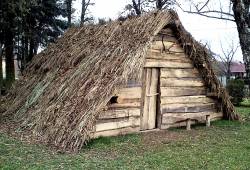Medieval heritage of Podravske Sesvete and its surroundings
At the beginning of the 16th century, according to the available tax inventories, there were more than 30 settlements in the wider area of manors and independent estates, some of which were established in the pre-Mongol period. Many are spatially registered and models of connecting them with the documents in which they were mentioned throughout history have been developed, while only a few of them have been archaeologically researched (Koprivnica Town Museum, 2013-2017).
Among the more significant medieval sites are certainly Zgruti in Mekiš, where an independent small estate consisting of several households was established in the 12th century. In the later phase of life, the settlement joined the Gorbonok manor, and by that time a new satellite settlement had already been developed a bit further north. The settlement was organized and equally oriented buried houses were found with certain interspaces which served as passages (road?). A multidisciplinary research has shown that these are the lost medieval settlements of Siget (Zygeth) and Mali Siget (Kiszygeth), whose basic economy relied mostly on livestock. In such an exchange of goods, a strong settlement was developed which had an advanced communication with Central European countries. This was confirmed by the accidental discovery of silver jewelry and money buried in the 14th century.
The site on Ruškova Greda north of Podravske Sesvete, surrounded by deep forests and watercourses, preserves the remains of a scattered type of medieval settlement, while the most significant finding in the excavations is a one-room above ground house from the beginning of the 14th century. Three pairs of wooden pillars carried a tent roof structure which reached to the floor, while the living area could have occupied a surface of about 20 m2, the construction of which is located in a park in the center of Podravske Sesvete. In addition, there are several interesting findings of multi-purpose domed (bread) ovens which speak of certain eating habits of the medieval community there. It is interesting that this area was used for a short time at the beginning of the 17th century when a half-buried house with a basement and a side well was built, which confirms that, after the Ottoman threat had passed, the population returned to the locations of former settlements.
In the latter case, it is not possible to determine which medieval settlement or property is in question, but near Crlenika, located right next to the Drava River, one could think of the Podravje (Podrawye, Drawamelleky) area or municipality which was of great strength and importance at the end of the 15th century. The adjective derived from it can sometimes be seen in the names of noblemen, such as Ivan Tahy. Considering the large area of the medieval settlement in Crlenika in relation to other locations, the geomorphologically most favorable conditions (raised beam), the proximity of a strong settlement on Zgruti and the centuries-long continuity of occupation (9th - 16th century), it is likely that its locations should have been right there.
For many other historical settlements (e.g., Berčin, Krajnica, Blata, Nart, Boletina, Ternovica, Orešje, Suha Reka, Vrhovljan, Potok, etc.) it will be necessary to persist in searching for historical sources, compare topography and then define them spatially through archaeological research. Undoubtedly, these are places where life flourished throughout the Middle Ages and to which the noble families Vitez od Sredna (at the Hungarian court) and then Tahija (from Zlatarovo zlato) are connected. Although this life was interrupted for two centuries by the arrival of the Ottomans, the population returned (physically, with culture and customs) and bestowed a unique identity upon today's community.




